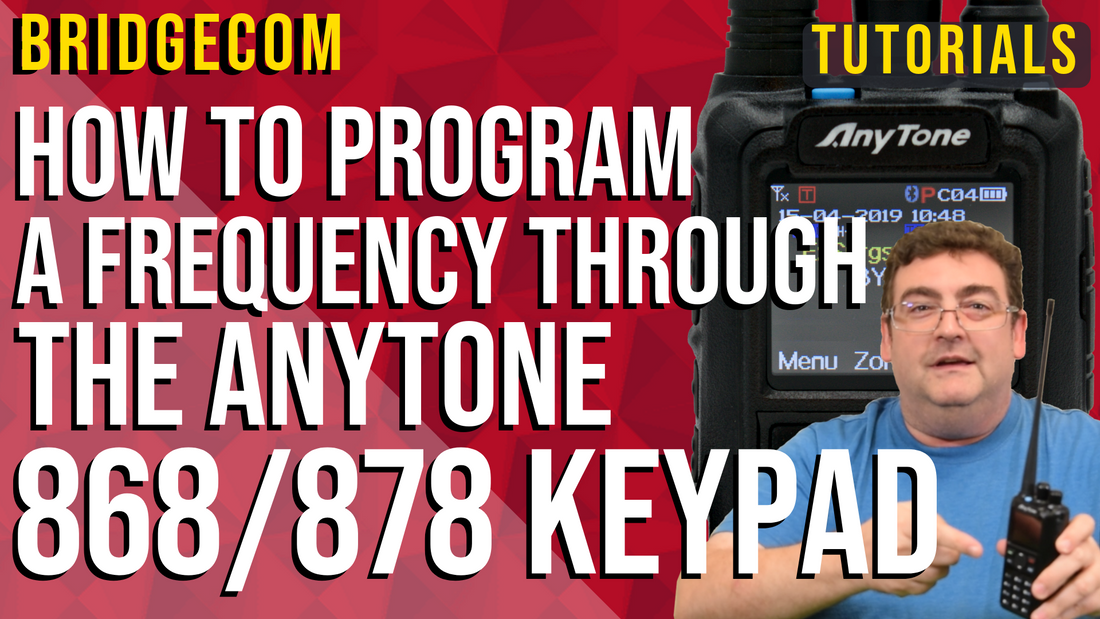
How to Program a Digital Frequency Through the AnyTone 868/878 Keypad
Want to get the AnyTone 878 PLUS now? Click here to learn more about the incredible radio everyone is raving about >> http://bit.ly/2ksWW3O
Hi, I'm Sebastian, KBØTTL. Today we're gonna be showing you how to program a digital frequency into the AnyTone 868 or This will be useful for anybody who’s gone ahead and set up their codeplug on their 868 or 878. This will be useful, say you already have your talkgroup list in, you already have your contact list in, you've already done some playing around on the 878 but on the fly, you want to go ahead and add in a channel. On the road, wherever. So let's get started.
The first step to the process is to go ahead and get out of memory mode, into VFO mode. You're going to enter the first frequency of your frequency pair that is your monitor frequency. In this case, we're gonna go ahead and use a DVMEGA hotspot which is tuned to 446.525. So we're gonna hit “446.525#” and that'll enter in the zeroes and fill in the frequency here for us. We're going to have to set up the specifics for our digital channel, which include, color code, time slots, talkgroup, bandwidth - for digital we're going to want Narrow band obviously. Once we have all this selected, we can have which channel we wish to save it to, in memory, and name the channel. So here it goes. Okay 446.525 is the frequency, or part of the base pair frequency we want. Because this is going to a hotspot and not a repeater, we're actually going to put this in as a simplex frequency. To do a repeater you would go in Duplex but we'll show you that here as well here just momentarily. So we are going to go to Settings. We are going to go to Channel Settings in this case. For Channel Type - Digital. Hit our Back button. Select your Power. Because I'm going to a hotspot, which is in the same room as I am, I'm gonna select Low Power. For repeater, honestly you're gonna go with high power or turbo power, for the full seven watts on this radio. Okay, so again, Settings. Channel Settings. Bandwidth. Remember I said to select Narrow band for digital, so Narrow. Receive frequency. You can Confirm. The Delete button actually doesn't delete it out, it does go back. Transmit frequency is what you would use if you were using a Duplex operation or a repeater. In this case, receive and transmit frequency will be the same. We'll select your Name later after we enter in the other variables. TX Allow - Always is a good default setting whether you're using a repeater or a hotspot. And let's go Back. You can see the DIG here, which denotes that we are now in digital frequency. We're gonna go ahead and select our talkgroup. Use World-wide as a default. Okay, so now we are set up - 446.525 World-wide. We have our hotspot which is acting as our local repeater here. If we were to key the radio up, we would be connecting then to this particular talkgroup. “This is KBØTTL, monitoring.” And success, we're seeing somebody here. They're not too talkative, but we have literally connected here to this talkgroup at our local repeater or hotspot. Let me give it a try back here again. We should be able to hear some folks comin' over here. This is KBØTTL, monitoring. Okay, we've successfully programmed in our frequency. Now what we need to do, is turn our frequency that we've programmed into a program channel. I've gone through my channels. I currently have 33 channels that are filled up in my radio. So we're going to start with channel 34 when we add this to codeplug in my case. Settings. Channel Settings. New Channel. Input number We're 34. Confirm. Channel Name. I'm just gonna go ahead and call this a generic name for now. I'm gonna call it Worldwide or WW for short. You can call it whatever you like. Confirm. I'm gonna go ahead and add it to my DV Mega Zone. You can edit to whichever zone you like. If you have more than one zone, you'll be able to scroll up and down here and select which zone. Confirm to save, push select again. Channel is saving. We'll go ahead and hit our back button and exit. Now I'm gonna switch to channel mode by pushing my P1 button. Getting out of VFO. We're on channel eight. Now I'm gonna swing up to 34, which is the channel that I just created, and there we are, Worldwide DVMega zone. We could hear someone checking on there but nobody talking on the group here as of yet. It's typically a pretty active group so it's surprising me that we're not hearing anybody here as of yet. Right there we could see just briefly that that was the ID number or DMR ID number of the member. Apparently a newer DMR member id as we don't have it in our contacts list yet.
Thank you for watching. This is Sebastian, KBØTTL and 73.
Want to get the AnyTone 878 PLUS now? Click here to learn more about the incredible radio everyone is raving about >> http://bit.ly/2ksWW3O







4 comments
So how do you get out of memory mode????
Good stuff. Only problem was the light making the screen hard to see as the radio tilted back and forth.
I was on vacation last week in FL and this process works great. I learned a new trick from this video that I can save the channel. Thanks for the great video. 73.
still not as easy as programing an analog radio.